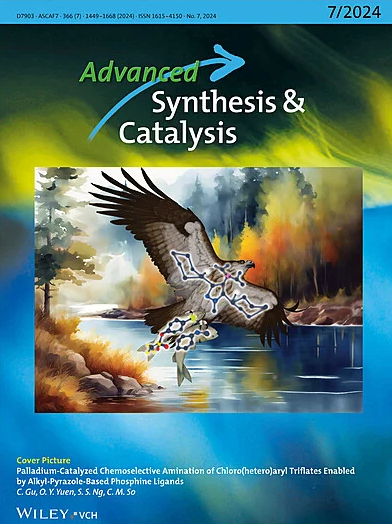烯烃和炔的直接光引发溴磺化反应
IF 4
2区 化学
Q2 CHEMISTRY, APPLIED
引用次数: 0
摘要
报道了对甲基磺酰溴与炔烃直接光引发溴磺酰化反应。该反应使用最大波长为400纳米的低功率辐射。该反应在室温下无金属条件下进行。提出了一种光催化双亚胺添加剂,可显著提高炔溴磺酰化反应的立体选择性,提高产物收率。用49个算例说明了反应范围。提出了β-溴基砜后续功能化制备有价值产品的方法。本文章由计算机程序翻译,如有差异,请以英文原文为准。

Direct Photoinitiated Bromosulfonylation of Alkenes and Alkynes
The reaction of direct photoinitiated bromosulfonylation of alkynes and alkenes with p-tolylsulfonyl bromide is reported. Low-power radiation with a maximum wavelength of 400 nm is used for the reaction. The reaction proceeds at room temperature under metal-free conditions. A photocatalytic bisimine additive is proposed that significantly increases the stereoselectivity of the alkyne bromosulfonylation reaction and increases the yield of products. The reaction scope is demonstrated with 49 examples. Methods for the subsequent functionalization of β-bromovinylsulfones to obtain valuable products are proposed.
求助全文
通过发布文献求助,成功后即可免费获取论文全文。
去求助
来源期刊

Advanced Synthesis & Catalysis
化学-应用化学
CiteScore
9.40
自引率
7.40%
发文量
447
审稿时长
1.8 months
期刊介绍:
Advanced Synthesis & Catalysis (ASC) is the leading primary journal in organic, organometallic, and applied chemistry.
The high impact of ASC can be attributed to the unique focus of the journal, which publishes exciting new results from academic and industrial labs on efficient, practical, and environmentally friendly organic synthesis. While homogeneous, heterogeneous, organic, and enzyme catalysis are key technologies to achieve green synthesis, significant contributions to the same goal by synthesis design, reaction techniques, flow chemistry, and continuous processing, multiphase catalysis, green solvents, catalyst immobilization, and recycling, separation science, and process development are also featured in ASC. The Aims and Scope can be found in the Notice to Authors or on the first page of the table of contents in every issue.
 求助内容:
求助内容: 应助结果提醒方式:
应助结果提醒方式:


